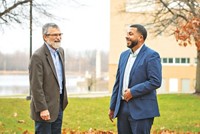Advertisement
Grab your lab coat. Let's get started
Welcome!
Welcome!
Create an account below to get 6 C&EN articles per month, receive newsletters and more - all free.
It seems this is your first time logging in online. Please enter the following information to continue.
As an ACS member you automatically get access to this site. All we need is few more details to create your reading experience.
Not you? Sign in with a different account.
Not you? Sign in with a different account.
ERROR 1
ERROR 1
ERROR 2
ERROR 2
ERROR 2
ERROR 2
ERROR 2
Password and Confirm password must match.
If you have an ACS member number, please enter it here so we can link this account to your membership. (optional)
ERROR 2
ACS values your privacy. By submitting your information, you are gaining access to C&EN and subscribing to our weekly newsletter. We use the information you provide to make your reading experience better, and we will never sell your data to third party members.
Careers
Blueprint For Boosting Diversity
University of Maryland, College Park, shares the secrets of its newfound success at attracting and retaining black chemistry Ph.D. students
by Lauren K. Wolf
December 19, 2011
| A version of this story appeared in
Volume 89, Issue 51

Sixty-two black chemists earned Ph.D.s in the U.S. in 2009, the last year for which data are available from the National Science Foundation. That’s just 2.6% of all chemistry Ph.D.s awarded in the country that year.



Not including historically black institutions, most major universities contribute to that small percentage by graduating zero or one African American chemistry Ph.D. students annually. So a big school stands out when it awards four of the degrees at one time, a feat accomplished by the University of Maryland, College Park, last year.
Those Ph.D.s were the result of a coordinated effort by the department of chemistry and biochemistry at Maryland to boost the quality and diversity of its graduate population. Maryland aims to join the ranks of top producer Louisiana State University (LSU), which has awarded 9.0% of the black chemistry Ph.D.s in the U.S. in the past 10 years. On the basis of Maryland’s success so far, chemistry department chair Michael P. Doyle thinks he has the right formula for reaching that goal.
Prior to 2003, Maryland’s chemistry department was home to no more than three or four black Ph.D. candidates each year, and as is the case at other big schools, it graduated either zero or one of those students annually. Today, the department boasts 20 black grad students out of a total population of 170.
“The way we got there is interesting,” Doyle says. After arriving at the at College Park chemistry department in 2003, he attended a meeting of the National Organization for the Professional Advancement of Black Chemists & Chemical Engineers (NOBCChE). “It was unlike any meeting that I had ever experienced,” he says, referring to the conference’s close-knit family atmosphere. It inspired him to institute measures to increase the department’s diversity. “We live in a culturally diverse community,” Doyle says. “We should have a population of students that look like that community.”
The U.S. population, for instance, is about 13% African American. For black students to be only 2.6% of the chemistry Ph.D. population is not enough, Doyle says. The figure is also especially low for the University of Maryland, which is located in a state that’s 29% black.
One of the most important pieces of the diversity puzzle that Doyle put into place at Maryland was to establish a two-year graduate fellowship for African American chemists. To do that, he collaborated with the National Institute of Standards & Technology, in Gaithersburg, Md. The institutions split the cost of the fellowship, which includes a $30,000 annual stipend, tuition, and a 10-week internship at NIST for one incoming student.
Named after renowned African American NIST physical chemist Dolphus E. Milligan, the fellowship began taking applications in 2006. Each year, a committee narrows a candidate pool to five finalists on the basis of their credentials. Those finalists then give short presentations highlighting their undergraduate research before a panel of judges. In the program’s inaugural year, Doyle says, three finalists who didn’t win the fellowship still came to Maryland. “That set off everything.”
Domonique O. Downing and Rennisha Wickham, fifth-year Ph.D. candidates at Maryland on the verge of graduating, were two of those original finalists. During the fellowship selection process, “the university really impressed us as far as their interest in us,” Downing says. Wickham agrees, citing the welcoming atmosphere as a reason for choosing to attend Maryland. “I liked the vibe I got,” she says. “I felt like they sought us out, not just because we’re black, but because of our accomplishments.”
Around the time that Doyle was making plans for the Milligan fellowship, Maryland petitioned to set up a student chapter of NOBCChE. The organization plays a big role in both the professional and social lives of the students, whether it’s at the campus or the national meeting level, Doyle says.
Both Downing and Wickham have served as president of the Maryland NOBCChE chapter, which offers tutoring, fellowships, and career workshops to its members. Most important, Downing explains, the chapter offers support. “All grad students wonder at one time or another, ‘Why am I here?’ With a support system in place, it makes it much easier to get yourself through” the long years of grad school.
“We tutor, we do demonstrations,” Wickham says. “We just try to get people together.” And the chapter makes an effort to send its members to the annual national NOBCChE meetings to make career connections and present their research. This year, Maryland sent nine students to the meeting in Houston (C&EN, May 9, page 42).
Between 2006 and 2008, in multiple faculty searches, Maryland’s chemistry department also hired three black professors. These top researchers and educators have bolstered diversity efforts because they “reflect for the students that there is no stopping point in their careers and that they can go on to do whatever they want,” Doyle says.
Nicole LaRonde-LeBlanc, a biochemist who joined the Maryland faculty in 2006, says she remembers applying to grad school with other highly qualified black students who were basing their school choice on the presence of diversity. For a lot of these students, “having someone who understands where they’re coming from and what their challenges are is important,” she says.
One professor in particular, Herman O. Sintim, seems to resonate with the students. “He’s a pretty young professor,” Wickham says. “That’s pretty inspiring.” Learning how the bioorganic chemist navigated through grad school—he got his Ph.D. at the University of Oxford—and figured out what he wanted to do is helpful to the students, she says. “The fact that Maryland invests in quality people like him is important.”
Having role models for students hasn’t helped just at Maryland. At LSU, which has dominated the black chemistry Ph.D. scene, professor and one-time chemistry department chair Isiah M. Warner has been a big draw for grad students. Warner is “a magnet,” Doyle says. “He’s an inspiration” as a well-known minority success story. And the school puts out the numbers it does because Warner is there and is intimately involved, Doyle adds.
Warner, a Howard Hughes Medical Institute researcher, acknowledges that his efforts and status have contributed to LSU’s success, but he doesn’t necessarily think African American faculty members are vital to boosting a program’s diversity. “You just need a faculty member—of any color—who is motivated,” he says.
When asked what else has contributed to the LSU chemistry department’s diversity statistics, Warner cites the department’s good relationships with universities that have high minority populations and LSU’s excellent recruiter. He also says having all of the faculty members at LSU on board with the diversity efforts has been crucial.
Faculty support has been important at Maryland as well, Doyle says. A diversity program like this, particularly with the fellowship, is expensive, he explains. “Because we had to divert resources from other things to recruit minority students, I’m sure that our faculty members were initially skeptical,” he says. “But I’ve heard from them over the past few years nothing but praise—that this is the best program we’ve ever done.”
No matter the strategy, both Warner and Doyle say establishing a critical mass of African American students in a program is what enables a diverse population to take off and eventually become sustainable. “Word spreads” about the reputation of the program, Maryland’s Sintim explains. Students then flock to the department, and the population becomes largely self-sustaining. For LSU, this mass was established when Warner arrived in 1992 from Emory University with five black grad students in tow. And for Maryland, everything kick-started with the four fellowship finalists in 2007.
For some schools, however, it’s not easy to establish that critical mass. At Massachusetts Institute of Technology, “the needle has been surprisingly fixed,” says Timothy M. Swager, professor and former chair of the chemistry department. For some years, MIT has been seeking to up the number of black graduate students in its program, but like other major universities, it graduates, on average, zero or one black chemistry Ph.D.s per year.
“We have a NOBCChE chapter,” Swager says, “and every minority student who comes to the department gets a fellowship, so it’s actually very desirable for faculty to recruit them.” Those measures have helped, but they have yet to create a critical mass. The root cause of the problem for MIT, he says, is that the pipeline of quality black students in chemistry is not very full. And those top students who do trickle out of the spout are set on going to medical school rather than grad school. “Figuring out how to bring more of them into chemistry will be key to solving the problem,” Swager adds.
MIT recently joined NOBCChE in a Technology Education Partnership to help find quality students. In these collaborations, NOBCChE establishes links between major universities and historically black colleges and universities to help direct minority students to grad school. Maryland was the first to have a partnership with NOBCChE.
A lot of students matriculate at historically black schools, NOBCChE President Victor R. McCrary says, because that’s where they’re comfortable. Through Technology Education Partnerships, undergrad students can begin to transition to graduate programs at majority institutions by doing summer internships at those schools and by getting to know the faculty and environment there. With these agreements in place, McCrary says, “we’re hoping to move the needle” in coming years.
Making students comfortable in a majority environment and treating them well, LSU’s Warner says, is probably the best piece of advice he can give schools seeking to increase diversity. It defeats the purpose if you recruit the students to check off a diversity box and then don’t treat them well, he says. “You have to bring in students you believe in,” he adds. “If you believe in them, you’ll work with them and help them succeed.”





Join the conversation
Contact the reporter
Submit a Letter to the Editor for publication
Engage with us on Twitter